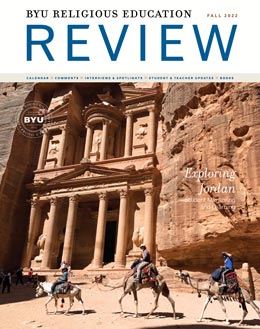The Book of Mormon Academy at BYU
Charles Swift
CHARLES SWIFT (charles_swift@byu.edu) IS ASSOCIATE CHAIR OF ANCIENT SCRIPTURE AT BYU.
In October 2013 a group of professors belonging to BYU’S Department of Ancient Scripture gathered with their department chair to establish a new organization. These colleagues were dedicated, faithful scholars of the Book of Mormon and unified in their desire to help build a scholarly group centered on an intensive, collaborative study of that sacred text. They decided to name this new association the Book of Mormon Academy (BOMA).
From its beginning, BOMA was established “not to compete with any other existing Book of Mormon outlet”[1] but to pursue its own mission of “provid[ing] the public, as well as fellow colleagues and students, with rigorous, faithful research concerning the Book of Mormon” through publications and presentations.[2] While initially BOMA was seen primarily as a research think tank to assist faculty whose primary research interest was the Book of Mormon, its scholars later sought ways to share their findings with a wider audience.
A major way that BOMA has sought to share its research is through a series of books. BOMA’s first publication, Abinadi: He Came Among Them in Disguise, introduced readers to an in-depth study of a prophet whose page count is significantly smaller than his prophetic imprint. The book probes the Abinadi episode through an array of academic lenses: literary, intertextual, intratextual, cultural, historical, and theological.[3] The second volume, Illuminating the Jaredite Records, presented an extensive study of the records of the people of Jared, particularly the book of Ether. Scholars explore the influence of these texts on later Nephite and Lamanite societies, their mention of intriguing cultural-historical aspects, their narratological structure, and their pedagogical value.[4]
The third book BOMA published, Samuel the Lamanite: That Ye Might Believe, focused on a careful look on the sermon and story of a peculiar prophetic figure: his prophecies, his sermon sources, his confrontation of prejudice, his ethics of wealth, and more.[5] The most recent volume, They Shall Grow Together: The Bible in the Book of Mormon,[6] offers readers insights into the textual affinity of these two books in terms of their words (thousands of biblical allusions interlace the Nephite text) and worlds (the influence of Moses, Deuteronomy, and the Tower of Babel in the Book of Mormon, as well as shared origins, culture, theology, and ritual). Members of BOMA are currently working on another multifaceted volume, on the prophet Jacob, that they hope to publish within the next two years. Some of the work from these volumes has been presented in public settings such as BYU’s Education Week.
Preparing such books for publication is no small task, and BOMA’s monthly meetings during the academic year are sometimes filled with discussions about an upcoming volume. For example, the scholars offer suggestions as they review possible topics for the book or listen to colleagues share the chapters they are working on. They also may devote most of the meeting to discussing a chapter in the Book of Mormon, exploring what insights and perspectives they can gain from one another and from what Church leaders and other working scholars have written. Additionally, they have been privileged to hear from guest speakers who generously share their understanding of the text. In the past, the chair of the academy has invited members of the group to present on various topics while leaving time for an enthusiastic, worthwhile discussion with colleagues who are united in their faith but who also bring a healthy diversity of perspective and opinion.
In fact, among the strengths of BOMA is this combination of unity and diversity. The latter is seen in their educational backgrounds: doctorates earned by current members of the academy include Hebrew studies, religion (early Christianity), New Testament, Near Eastern languages and cultures, English, Northwest Semitics, Near Eastern religions, instructional psychology and technology, history of Christianity, Egyptian archaeology, Egyptology, linguistic anthropology, sixteenth-century Bible translation, Hebrew Bible, and philosophy. Each of these disciplines prepares scholars to critically analyze texts and effectively discuss that analysis in writing.
Through the lens of their respective disciplines—coupled most importantly with the lens of the restored gospel—BOMA members study the text of the Book of Mormon and produce writings they hope will benefit members of the Church in particular, but also other interested readers. Over the past nine years, the Book of Mormon Academy has had several different chairs lead the organization, but one constant has been the commitment among its members to bring to the discussion table their skills, faith, and intellect as they study and search the Book of Mormon.
Notes
[1] Camille Fronk Olson, “Book of Mormon Academy: Proposed Purpose,” January 2017, document in author’s possession.
[2] “Book of Mormon Academy,” 20 October 2017, document in author’s possession.
[3] Shon D. Hopkin, ed., Abinadi: He Came Among Them in Disguise (Provo, UT: Religious Studies Center, Brigham Young University; Salt Lake City: Deseret Book, 2018).
[4] Daniel L. Belnap, ed., Illuminating the Jaredites (Provo, UT: Religious Studies Center, Brigham Young University; Salt Lake City: Deseret Book, 2020).
[5] Charles Swift, ed., Samuel the Lamanite: That Ye Might Believe (Provo, UT: Religious Studies Center, Brigham Young University; Salt Lake City: Deseret Book, 2021).
[6] Charles Swift and Nicholas J. Fredrick, eds., They Shall Grow Together: The Bible in the Book of Mormon (Provo, UT: Religious Studies Center, Brigham Young University; Salt Lake City: Deseret Book, 2022).
